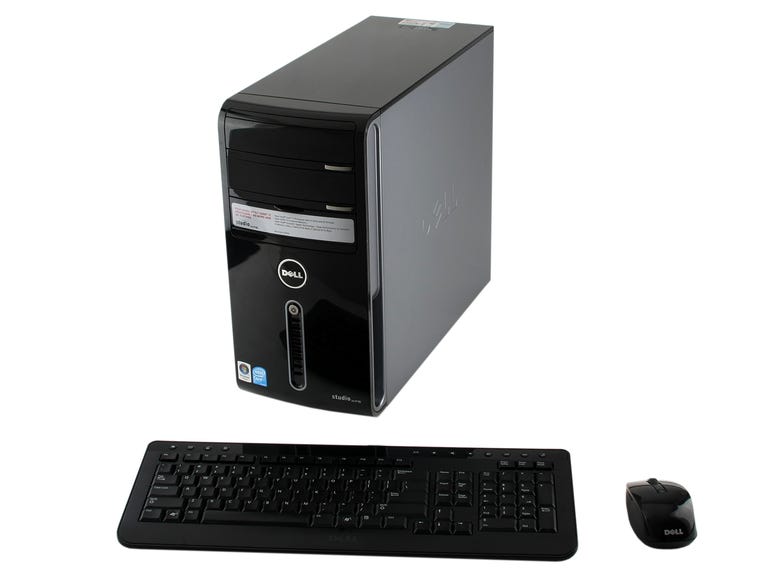 Why You Can Trust CNET
Why You Can Trust CNET Dell Studio XPS-122B review: Dell Studio XPS-122B
Dell Studio XPS-122B
Dell's fixed-configuration Studio XPS-122B is essentially a showcase for Intel's relatively new Core i7 desktop processors. This $999 Dell provides all of the features we expect to find at this price, as well as very aggressive multitasking and multithreaded application performance. The Studio XPS-122B has few frills, but anyone looking for raw computing power will be more than satisfied with this off-the-shelf Dell.
The Good
The Bad
The Bottom Line
Like other tower desktops we've reviewed lately, the Studio XPS's case is serviceable and attractive enough. You might not show it off for its looks, but the glossy black plastic exterior won't detract from your decor, either. The front panel has the standard pair of optical drive bays (one empty, one with a DVD burner). Underneath them, a small door slides down to reveal the media card reader, audio ports, a FireWire input, and four USB ports.
| Dell Studio XPS-122B | Velocity Micro Edge Z5 | |
| Price | $999 | $999 |
| CPU | 2.67GHz Intel Core i7 920 | 2.93GHz Intel Core 2 Quad Q9400 |
| Memory | 4GB 1,066MHz DDR3 SDRAM | 4GB 800MHz DDR2 SDRAM |
| Graphics | 512MB ATI Radeon HD 4850 | 512MB ATI Radeon HD 4850 |
| Hard drives | 640GB, 7,200rpm | 750GB, 7,200rpm |
| Optical drive | dual-layer DVD burner | dual-layer DVD burner |
| Networking | Gigabit Ethernet | Gigabit Ethernet |
| Operating system | Windows Vista Home Premium SP1 (64-bit) | Windows Vista Home Premium SP1 (64-bit) |
We could have matched the Dell directly against several other desktops in this price range, but we've chosen the custom-built Velocity Micro Edge Z5 because of the exact price match. Dell's plastic exterior looks a little cheap compared with the Edge Z5's all-metal case, and the Velocity Micro system also has a beefier 550-watt power supply-- the Dell only has a 350-watt supply. That means you could reasonably put a higher-end 3D card in the Velocity Micro system if you decide to upgrade down the road. The Studio XPS-122B will likely limit you to midrange 3D cards and lower.
(Shorter bars indicate better performance)
(Shorter bars indicate better performance)
(Shorter bars indicate better performance)
(Longer bars indicate better performance)
| Rendering Multiple CPUs | Rendering Single CPU |
Velocity Micro has the clear edge in its case and its future-mindedness, but the performance picture is less clear. The two systems are virtually tied on our Photoshop test, but they trade wins across the rest of our benchmarks. Velocity Micro pulls ahead on our iTunes test, likely because of its faster core CPU speed. However, the Dell is a better multitasker, rivaling even the 20-inch iMac, a multitasking champ in its own right. The Dell's Core i7 chip also helps it speed ahead on our Cinebench test. Thus, if you frequently use more than one program at a time, or if you use an application you know will use multiple CPU cores, the Dell ends up being best option out of several PCs in its price range.
(Longer bars indicate better performance)
| 1,920x1,200 | 1,280x1,024 |
(Longer bars indicate better performance)
| 1,920x1,200 | 1,440x900 |
While the Dell's 512MB Radeon HD 4850 graphics card is fast enough for acceptable frame rates on common PC games, it can't quite muster the same performance as the Velocity Micro system. Again, we think the Edge Z5 sneaks ahead because of its faster core CPU speed. In practical terms, the Dell will let you play even demanding 3D games at decent image quality on 19- and 20-inch LCDs. Once you start ramping up to 22- or 24-inch displays, you will likely feel some lag on the Dell--but less so with the Velocity Micro system.
Rounding out the Studio XPS-122B, you get a spare hard-drive slot, rear inputs for an eSATA hard drive, and an optical S/PDIF audio port. Extras such as wireless networking, a TV tuner, a Blu-ray drive, or an HDMI output are all absent. As we said, this system focuses on performance, with few pretentions toward your living room or any other nonstandard usage model.
Dell backs the Studio XPS-122B with its typical year of parts-and-labor warranty coverage and 24-7 toll-free phone support, in keeping with the rest of the industry. Its online help is tied to system-specific IDs for each configuration, which makes tracking down items such as FAQs and drivers easy and productive.
Find out more about how we test desktop systems.
System configurations:
Apple iMac (20-inch, 2.66GHz, Winter 2009)
Apple OS X 10.5.6; 2.66GHz Intel Core 2 Duo; 2GB 1,066MHz DDR3 SDRAM; 256MB (shared) Nvidia GeForce 9400m integrated graphics chip; 320GB 7,200rpm hard drive.
Dell Studio XPS-122B
Windows Vista Home Premium SP1 (64-bit); 2.67GHz Intel Core i7 920; 4GB 1,066MHz DDR3 SDRAM; 512MB ATI Radeon HD 4850 graphics card; 640GB 7,200rpm Samsung hard drive.
Gateway FX6800-01e
Windows Vista Home Premium SP1 (64-bit); 2.67GHz Intel Core i7 920; 3GB 1,600MHz DDR3 SDRAM; 512MB ATI Radeon HD 4850 graphics card; 750GB 7,200rpm Seagate hard drive.
HP Pavilion Elite m9515y
Windows Vista Home Premium SP1 (64-bit); 2.5GHz AMD Phenom X4 9850; 8GB 800MHz DDR2 SDRAM; 768MB Nvidia GeForce 9600 GS graphics card; 750GB 7,200rpm Hitachi hard drive.
Velocity Micro Edge Z5
Windows Vista Home Premium SP1 (64-bit); 2.93GHz Intel Core 2 Quad Q9400; 4GB 800MHz DDR2 SDRAM; 512MB ATI Radeon HD 4850 graphics card; 750GB 7,200rpm Hitachi hard drive.


